Editor’s Note: Fred Patten has been a friend and colleague of mine for over 30 years. A respected comics and anime historian and a veteran of “the golden age of comic fandom”, a pioneering group of comic book and animation enthusiasts whose efforts in the 1960s led to an organized fandom – without which today’s mega Comic Cons, comics shops and Hollywood’s current comic book fixation would not exist. I have asked Fred to occasionally drop into this blog to share his thoughts, ruminations and knowledge.
Today, Fred talks about his life in fandom – followed by some thoughts about his friend Osamu Tezuka.
Jerry has invited me to contribute to his blog, Cartoon Research. Hmmm — what do I have to say that animation fans would be interested in?
I often feel a love/hate relationship with Japanese animation. It may be what I am best known for, but it is not the only aspect of animation that I’m interested in. It may be my fault, but I’m more than just “the anime guy”.
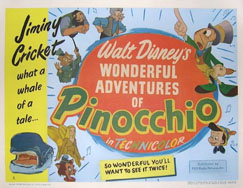 The first animation that I can remember seeing was when my mother took me to see Disney’s Pinocchio. Pinocchio was released on February 7, 1940, about ten months before I was born, so what I remember must have been the first re-release in October 1945. I remember a bit better the second re-release in February 1954. I was just 13, and my grandmother took me and my younger sisters to see it at the Mesa Theater, about a mile from home. I loved it so much that I persuaded her to let me stay alone to watch it a second time, and walk home alone afterward.
The first animation that I can remember seeing was when my mother took me to see Disney’s Pinocchio. Pinocchio was released on February 7, 1940, about ten months before I was born, so what I remember must have been the first re-release in October 1945. I remember a bit better the second re-release in February 1954. I was just 13, and my grandmother took me and my younger sisters to see it at the Mesa Theater, about a mile from home. I loved it so much that I persuaded her to let me stay alone to watch it a second time, and walk home alone afterward.
Of course, there were all of the Disney movies inbetween. Make Mine Music and Song of the South (I may be misremembering, but I’d swear that there is a 1901 calendar visible on the wall in Johnny’s father’s Atlanta newspaper office, for all that everyone says that the movie is so undated that people can mistake it for being set during the Civil War) and Fun and Fancy Free, Melody Time and So Dear to My Heart, The Adventures of Ichabod and Mister Toad, Cinderella, Treasure Island and Alice in Wonderland and … the re-releases of older features like Fantasia and Dumbo during that time. But all America went to see Disney. When did I become an animation fan?
 The first Japanese animated features, Magic Boy and Panda and the Magic Serpent and Alakazam the Great, came to America in 1960, while I was in college. I saw them all. UCLA had occasional programs of “International Animation” on campus. I remember seeing the 1962 Japanese The Adventures of Sinbad at one of them.
The first Japanese animated features, Magic Boy and Panda and the Magic Serpent and Alakazam the Great, came to America in 1960, while I was in college. I saw them all. UCLA had occasional programs of “International Animation” on campus. I remember seeing the 1962 Japanese The Adventures of Sinbad at one of them.
My memory has failed on just how it happened, but somebody invited me to a series of Friday night cartoon screenings at the Hollywood home of Bob Konikow. These ran from about 1970 to 1973. The attendance was from a dozen to twenty people, crowded into a darkened living room to watch 16 m.m. prints of whatever the attendees owned or could borrow or check out of a studio’s film library. Mark Kausler and Milt Gray usually ran the projector. I saw Victor Haboush’s K-9000: A Space Oddity and Disney’s Victory Through Air Power here, and “Jack Warner’s personal print of Bob Clampett’s Coal Black and de Sebben Dwarfs” was shown by popular demand at almost every other meeting. I still don’t know why I was invited, because all the other attendees seemed to be either young professional animators (with an occasional visit by a “legend” like Bob Clampett or Frank Tashlin) or a published underground cartoonist. Bill Stout, Dave Stevens, John Pound, George DiCaprio, Robert Williams, Bill Spicer, Richard Kyle (I would go into partnership with him on Graphic Story World and Graphic Story Bookshop in Long Beach a couple of years later), Tim Walker, Art Vitello, John Bruno, Bob Foster, and others. The screenings ended when Bob Konikow moved away from Los Angeles, but by then I considered myself an animation insider.
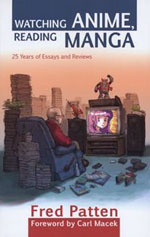 I was also active in science fiction fandom and comic-book fandom. The former led me to discover Japanese manga and then anime. I co-founded the first American anime fan club, the Cartoon/Fantasy Organization, in May 1977 (it’s still meeting every month). In 1980 I got the Comic-Con’s Inkpot Award for introducing anime to American fandom. Toei Animation’s Hollywood representative, Pico Hozumi, and TV producer Jim Terry who was trying to sell an American production of Toei’s TV giant-robot animation, provided me with lots of graphics to write articles for popular-culture magazines like Starlog on anime. This led to my writing enough articles over the next 25 years to fill a book: Watching Anime, Reading Manga: 25 Years of Essays and Reviews (Stone Bridge Press, September 2004).
I was also active in science fiction fandom and comic-book fandom. The former led me to discover Japanese manga and then anime. I co-founded the first American anime fan club, the Cartoon/Fantasy Organization, in May 1977 (it’s still meeting every month). In 1980 I got the Comic-Con’s Inkpot Award for introducing anime to American fandom. Toei Animation’s Hollywood representative, Pico Hozumi, and TV producer Jim Terry who was trying to sell an American production of Toei’s TV giant-robot animation, provided me with lots of graphics to write articles for popular-culture magazines like Starlog on anime. This led to my writing enough articles over the next 25 years to fill a book: Watching Anime, Reading Manga: 25 Years of Essays and Reviews (Stone Bridge Press, September 2004).
Anime also got me into the biggest fight that I have ever been in, with Bill Scott of Rocky and Bullwinkle fame, at the meetings of ASIFA-Hollywood. Scott dismissed Japanese animation as unimaginative costumed-hero stuff, in horribly limited animation. I rebutted, “You should talk! Rocky and Bullwinkle may be brilliant, but it’s hardly for the quality of its animation. You have it animated at one of the cheapest studios in Mexico City. As for the giant-robot stereotype, there’s much more variety in Japanese animation than there is in American animation. It’s that the anime fans don’t want to watch anything besides giant robots.” But it was a lost cause. I was drowned out by Scott and the other American animation-industry veterans chanting, “Poor animation! Awful animation!” I dropped out of ASIFA-Hollywood for several years.
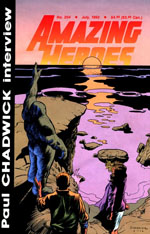 My record as a comics-fandom fanzine writer-publisher got me a job with Fantagraphics Books’ Amazing Heroes magazine. My most memorable moment was when I got press credentials to cover a press conference on Ralph Bakshi’s Cool World, which was just finishing production. There were about a dozen in the press party. We were given a tour of the busy animation studio, set up in a rented warehouse; and then Bakshi came out to say a few words about how imaginative Cool World was and how confident the producers were that it would be a hit. Any questions? A big man immediately asked how many cels had been made for the movie, and what arrangements had been made to sell them through a collectibles gallery? Ralph tried to steer the conversation back to Cool World as cinematic art, but the guy insisted on asking about the commercial market for the cels, as though the movie was just a ploy to manufacture saleable movie memorabilia. You could see Ralph fighting to keep his temper.
My record as a comics-fandom fanzine writer-publisher got me a job with Fantagraphics Books’ Amazing Heroes magazine. My most memorable moment was when I got press credentials to cover a press conference on Ralph Bakshi’s Cool World, which was just finishing production. There were about a dozen in the press party. We were given a tour of the busy animation studio, set up in a rented warehouse; and then Bakshi came out to say a few words about how imaginative Cool World was and how confident the producers were that it would be a hit. Any questions? A big man immediately asked how many cels had been made for the movie, and what arrangements had been made to sell them through a collectibles gallery? Ralph tried to steer the conversation back to Cool World as cinematic art, but the guy insisted on asking about the commercial market for the cels, as though the movie was just a ploy to manufacture saleable movie memorabilia. You could see Ralph fighting to keep his temper.
My article on Cool World appeared in the final issue of Amazing Heroes, #204 in July 1992.
In January 1991 I became the first employee of Carl Macek’s & Jerry Beck’s Streamline Pictures, turning my anime hobby into my profession. I worked at Streamline until it closed its doors, in March 2002. I became a freelance writer, and had three monthly columns on anime & manga, in Animation World Magazine, The Comic Buyer’s Guide, and Newtype U.S.A., at the time I had my stroke in March 2005 that ended my professional animation writing career.

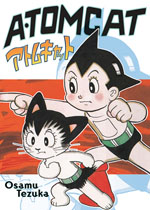 DMP Digital Manga Publishing has announced that it will publish the first American edition of Osamu Tezuka’s manga Atomcat on April 24th, possibly as “A Tomcat” – it’s hard to tell from the prepublication announcement. The pun is Tezuka’s. I met him on several occasions between 1977 and 1986, a little over two years before his death, and he was very proud to be able to make puns like “A Tomcat” in English, which he did not speak.
DMP Digital Manga Publishing has announced that it will publish the first American edition of Osamu Tezuka’s manga Atomcat on April 24th, possibly as “A Tomcat” – it’s hard to tell from the prepublication announcement. The pun is Tezuka’s. I met him on several occasions between 1977 and 1986, a little over two years before his death, and he was very proud to be able to make puns like “A Tomcat” in English, which he did not speak.
One pun, or reference, that did not work out was his August 1978 TV movie Bander Book, Tezuka’s version of Star Wars, which he showed at the Cartoon/Fantasy Organization, Los Angeles’ anime fan club, early in 1979. It was about the interstellar adventures of a young hero, Bander. I told Tezuka that the title should have been in the possessive, Bander’s Book. “But you say Jungle Book, not Jungle’s Book! Why isn’t it the same for Bander?” Another sort-of error was the August 1984 TV movie listed everywhere as “Bagi, the Monster of Mighty Nature”. Tezuka said that the intelligent cat-woman was deliberately named after Bagheera in The Jungle Book, so logically the title should be Baghi, the Monster of Mighty Nature. But the movie was unreleased in America or Britain, so a phonetic translation of “Bagi” in the title has become accepted as correct by everyone.
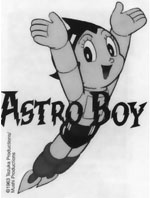 Tezuka originally considered Astro Boy, or Mighty Atom, to be “his baby”. The first Mighty Atom manga story was published in April 1951 in Shonen, a monthly boys’ magazine. Atom’s adventures were serialized in stories of varying lengths throughout the 1950s. Tezuka later said that he was extremely gratified by all the fan mail that the stories generated; except that, after Isaac Asimov’s science fiction began to be published in Japan, everyone started asking why Tezuka’s stories did not follow Asimov’s famous Three Laws of Robotics? Tezuka got tired of explaining that the Three Laws were just one author’s gimmick for his own stories, not a rule that all s-f authors had to follow!
Tezuka originally considered Astro Boy, or Mighty Atom, to be “his baby”. The first Mighty Atom manga story was published in April 1951 in Shonen, a monthly boys’ magazine. Atom’s adventures were serialized in stories of varying lengths throughout the 1950s. Tezuka later said that he was extremely gratified by all the fan mail that the stories generated; except that, after Isaac Asimov’s science fiction began to be published in Japan, everyone started asking why Tezuka’s stories did not follow Asimov’s famous Three Laws of Robotics? Tezuka got tired of explaining that the Three Laws were just one author’s gimmick for his own stories, not a rule that all s-f authors had to follow!
When Tezuka opened his own animation studio, Mushi Productions, in 1961 to produce TV animation based on his own manga, Mighty Atom was the obvious first choice. But Tezuka quickly found that what had been a pleasure became an onerous chore. Serials that had run in Shonen for almost a year were compressed into a single weekly half-hour episode for Fuji TV. Tezuka’s backlog of ideas for future manga stories were almost immediately used up for TV episodes, and he was forced to grind out new stories mechanically. Mighty Atom ran weekly, first on Fuji TV and later on NHK, the government channel, for 193 episodes, from January 1, 1963 to December 31, 1966. In the final episode, Atom dies by flying a planet-destroying bomb into the sun, to save Earth. The last half of the half-hour episode consisted of tearful memorials and tributes to Atom from all his friends and world leaders. Tezuka was making sure that public demand could not resurrect Mighty Atom.
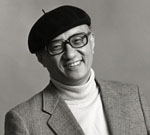 Tezuka’s attitude toward Mighty Atom gradually changed to regarding him as just a commercial property. Tezuka wrote/drew one serious two-year serial from January 1967 to February 1969, The Atom Chronicles, for the Sankei Shimbun newspaper, a retrospective adventure reconciling all discrepancies and answering many years of fan comments. (“If Mighty Atom is always in favor of peace and against violence, why does he have machine guns built into his ass?”) After that, Tezuka took it easy. When he was asked to draw a story showing Mighty Atom as a normal boy, Tezuka produced a two-pager showing what might have happened if Atom had not been programmed to be good, with him becoming a juvenile delinquent, shooting up drugs, and being arrested in a vice-house raid.
Tezuka’s attitude toward Mighty Atom gradually changed to regarding him as just a commercial property. Tezuka wrote/drew one serious two-year serial from January 1967 to February 1969, The Atom Chronicles, for the Sankei Shimbun newspaper, a retrospective adventure reconciling all discrepancies and answering many years of fan comments. (“If Mighty Atom is always in favor of peace and against violence, why does he have machine guns built into his ass?”) After that, Tezuka took it easy. When he was asked to draw a story showing Mighty Atom as a normal boy, Tezuka produced a two-pager showing what might have happened if Atom had not been programmed to be good, with him becoming a juvenile delinquent, shooting up drugs, and being arrested in a vice-house raid.
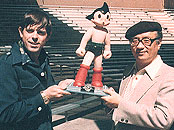 In 1980, the 1960s Mighty Atom TV series was so far in the past that Tezuka created a new TV series with state-of-the-art color animation. The New Mighty Atom (Shin Tetsuwan Atom), 52 episodes from October 1, 1980 to December 23, 1981, was not a series of independent stories as was the 1963-1966 series, but a continuous serial that told Atom’s life story as worked out in the late 1960s. It looked pretty, but it emphasized pathos over drama. Atom’s love of peace was extended to the extent of turning him into a crybaby weeping for all the supporting characters who died tragically at the end of each episode. Tezuka pointed out in conversation with me that Atom was always programmed to be a “good boy”, to avoid violence whenever possible; and therefore the new TV series made more logical sense than the 1963-1966 episodes. Maybe so, but as I said in an article, “Astro Old and Astro New” for the British Manga Max magazine, June 2000 (#18), “The black-and-white TV series may have been crudely produced, but it was imbued with a verve and sparkle which the prettier color remake almost completely lacked.” The new series was received politely by the Japanese public, but it was quickly forgotten.
In 1980, the 1960s Mighty Atom TV series was so far in the past that Tezuka created a new TV series with state-of-the-art color animation. The New Mighty Atom (Shin Tetsuwan Atom), 52 episodes from October 1, 1980 to December 23, 1981, was not a series of independent stories as was the 1963-1966 series, but a continuous serial that told Atom’s life story as worked out in the late 1960s. It looked pretty, but it emphasized pathos over drama. Atom’s love of peace was extended to the extent of turning him into a crybaby weeping for all the supporting characters who died tragically at the end of each episode. Tezuka pointed out in conversation with me that Atom was always programmed to be a “good boy”, to avoid violence whenever possible; and therefore the new TV series made more logical sense than the 1963-1966 episodes. Maybe so, but as I said in an article, “Astro Old and Astro New” for the British Manga Max magazine, June 2000 (#18), “The black-and-white TV series may have been crudely produced, but it was imbued with a verve and sparkle which the prettier color remake almost completely lacked.” The new series was received politely by the Japanese public, but it was quickly forgotten.
Tezuka was asked in 1986 by Smile Comics, a magazine for children, to create a series for it. He responded with Atom Cat (or Atomcat), Mighty Atom turned into a funny animal. It ran in Smile Comics from July 1986 to February 1987, and was clearly Tezuka’s parody of his own most famous work. Tsugio, a shy schoolboy constantly picked upon by the school bully (named Quaddafi), is given a superscientifically-enhanced kitten by two honeymooning(!) aliens. Atom finishes up Quaddafi and his gang, and becomes Tsugio’s regular pet and bodyguard.
Atomcat was a trifle, quickly ended. The last time that I saw Tezuka, in August 1986 at Japan’s National Science Fiction Convention, he jovially told me that he had just started a manga that I was sure to like, considering my other major interest in funny animals. Astro Boy as a cat!? WHY??? He chuckled and said something approximating, Why not? It was important to not take your work too seriously. Well, thanks to Digital Manga, now you can see it for yourself.


 Fred Patten (1940-2018) was an internationally respected comics and animation historian. He has written about anime or comic books for publications ranging from Animation Magazine and Alter Ego to Starlog. He was a contributor to The Animated Movie Guide (2005), and is author of Watching Anime, Reading Manga (2004, Stone Bridge Press), a collection of his best essays, and Funny Animals and More (2014, Theme Park Press), based upon his early columns here on Cartoon Research. He passed away on November 12th, 2018.
Fred Patten (1940-2018) was an internationally respected comics and animation historian. He has written about anime or comic books for publications ranging from Animation Magazine and Alter Ego to Starlog. He was a contributor to The Animated Movie Guide (2005), and is author of Watching Anime, Reading Manga (2004, Stone Bridge Press), a collection of his best essays, and Funny Animals and More (2014, Theme Park Press), based upon his early columns here on Cartoon Research. He passed away on November 12th, 2018.





































Recently, I found Atomcat comics and I I really like it.
That was interesting. I didn’t know there was a cat version of “Astro Boy”. Was there an anime series of “Atom Cat”?
Cool new column! Thanks.
There is no anime series of Atom Cat yet, but we can always hope.
The art on the Graphic Story Bookshop business card should be credited to s-f artist George Barr. Richard Kyle’s cards had his name on them, of course. The bookshop opened in January 1972. I was more of a silent partner in it, in charge of ordering foreign comics (including Japanese) while Richard ran the shop. I sold out my partnership to Richard in December 1975, although I continued to do my comics shopping there and to chat with Richard until he closed the shop (long since renamed Richard Kyle, Books) in 1996.
The color photograph of Osamu Tezuka holding the Astro Boy statuette is with Robin Leyden, who made the statuette, at Universal City Tours where Robin was working, in February 1978.
There was also “Jetter Mars”, Tezuka’s ‘self-plagiarism’ of Astro Boy, created in 1977. When he planned to remake the Astro Boy original 60’s series in color, but was unable to do so becuase of legal problems (though he finally suceeded in 1980), he came up with this clon, whose anime series was made by Toei: http://en.wikipedia.org/wiki/Jetter_Mars
Though it never aired in the U.S., “Jetter Mars” was quite popular in several Latin American countries.
This is the first I’ve heard of “Atomcat”. I really should check it out.
During my childhood I flew back-and-forth between Japan and USA (I primarily lived in Japan), so I grew up watching both Japanese and American cartoons together.
If you ever look at my cartoons, you can see that the style is a hybrid of Japan and USA cartooning styles.
Tezuka told me that Toei Animation commissioned him to create “as close a copy of Mighty Atom as he was comfortable with.” He did not see much point in just making a duplicate of Mighty Atom with cosmetic differences, so he came up with a little-boy robot who was created by two scientists, Dr. Kawashimo who gave him artificial intelligence, and Dr. Yamanoue who built his body with superscientific weaponry in it; but no programming to be either good or bad. Dr. Kawashimo wanted to use Jetter Mars to help humanity, while Dr. Yamanoue wanted to use him as a mercenary for the highest bidder. Jetter Mars was mostly a bewildered little robot whose two creators were always arguing that he should follow me; no, not him, me!; no, ME. Tezuka’s concept was that Jetter Mars would sometimes follow Dr. Kawashimo and sometimes Dr. Yamanoue, although when he took Dr. Yamanoue’s orders, the story would work out that his more violent actions would inadvertently work out for the best for humanity.
Tezuka’s contract was that he would create the basic concept for the series, and the plot outlines for the first five episodes. In episode #6, Dr. Yamanoue was killed off, Jetter Mars went to live permanently with Dr. Kawashimo, and the series became an insipid copy of Mighty Atom with kindly Dr. Kawashimo as kindly Dr. Ochanomizu.
The Cartoon/Fantasy Organization got enough episodes to agree with Tezuka; after episode #5 it went downhill fast. The most memorable thing about the series was that Toei got a real little boy about 7 or 8 years old who did not have any voice acting experience to play Jetter Mars, including singing the lively theme song enthusiastically but very off key.
I remember both seeing the OP/ED of, and hearing the theme song of, Jetter Mars! It was a cute theme song, indeed. I can only imagine how Tezuka would’ve wanted to remake Astro-Boy back in that time! 🙂
What I’m curious about is where could’ve Atomcat gone, had it continued past 7 chapters. Having read it myself, the whole thing started off as a simple comedy, but by the end of the last chapter, it’s clear Tezuka would’ve attempted to bring a more serious side. I wonder if perhaps he was gonna explore the relationships of all the characters. Atom, Tsugio, Tsugio’s parents, Erica, Qaddafi, Munch, etc. Tis a shame he only did 7 chapters…..hmm…you think someone should revive it?